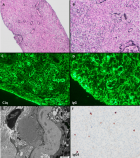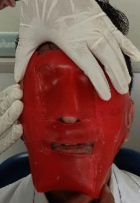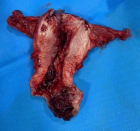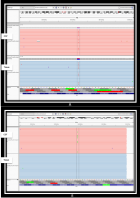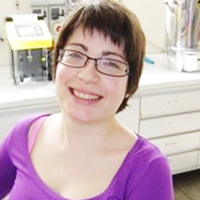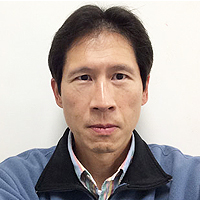Abstract
Short Communication
Synthesis and Biological Evaluation of Fluorescein-Tagged 1-Methyl-o-carborane for Boron Neutron Capture Therapy
Lucas A Kuzmanic, Lauren E Zuidema, Jason A Misurelli, Kazuko Uno, Sherine F Elsawa*, Masao Takagaki* and Narayan S Hosmane*
Published: 26 October, 2018 | Volume 2 - Issue 1 | Pages: 075-081
Fluorescein was conjugated with 1-methyl-o-carborane and the resulting bioconjugate was biologically evaluated through microscopic and flow cytometric studies in pancreatic cancer and squamous cell carcinoma cell lines. The uniform distribution of this bioconjugate, as well as its moderate cytotoxicity and higher boron content relative to present boronated delivery agents sodium borocaptate (BSH) and boronophenylalanine (BPA), provide justification for its further evaluation as a potential delivery agent for BNCT.
Read Full Article HTML DOI: 10.29328/journal.aac.1001016 Cite this Article Read Full Article PDF
Keywords:
Boron neutron capture therapy; Carborane; Fluorescein; Bioconjugate; Theranostic
References
- Yinghuai Z. Hosmane NS. Applications and perspectives of boron-enriched nanocomposites in cancer therapy. Future Medicinal Chemistry. 2013; 5: 705-714. Ref.: https://goo.gl/eZRN1b
- Barth RF, Vicente MG, Harling OK, Kiger WS 3rd, Riley KJ, et al. Current status of boron neutron capture therapy of high grade gliomas and recurrent head and neck cancer. Radiat. Oncol. 2012; 7: 146. Ref.: https://goo.gl/9RAJEi
- Hosmane NS, Maguire J. Zhu Y, Takagaki M. Boron and Gadolinium Neutron Capture Therapy for Cancer Treatment. Singapore: World Scientific Pub, 2012. 272. Ref.: https://goo.gl/ZV5n9C
- Nakamura H. Liposomal Boron Delivery for Neutron Capture Therapy. Methods in Enzymology. 2009; 179-208. Ref.: https://goo.gl/RE4ZWR
- Barth RF, Soloway AH, Brugger RM. Boron Neutron Capture Therapy of Brain Tumors: Past History, Current Status, and Future Potential. Cancer Investigation. 1996; 14: 534-550. Ref.: https://goo.gl/aLjkKb
- Patel H, Takagaki M, Bode BP. Snajdr I, Devangi P. et al. Carborane-Appended Saccharides: Prime Candidates for Boron Neutron Capture Therapy (BNCT). Biochemical and Biophysical Journal of Neutron Capture Therapy & Cancer Treatments. 2013; 1: 15-21. Ref.: https://goo.gl/Bjm4n6
- Varadarajan A, Hawthorne MF. Novel carboranyl amino acids and peptides: reagents for antibody modification and subsequent neutron-capture studies. Bioconjugate Chem. 1991; 2: 242−253. Ref.: https://goo.gl/dtmX34
- Kusaka S, Hattori Y, Uehara K, Asano T, Tanimori S, et al. Synthesis of optically active dodecaborate-containing Lamino acids for BNCT. Appl Radiat Isot. 2011; 69: 1768−1770. Ref.: https://goo.gl/2Vemj7
- Hattori Y, Kusaka S, Mukumoto M, Uehara K, Asano T, et al. Biological Evaluation of Dodecaborate-Containing L-Amino Acids for Boron Neutron Capturer Therapy. J Med Chem. 2012; 55: 6980–6984. Ref.: https://goo.gl/o6bZC9
- Agarwal HK, Khalil A, Ishita K, Yang W, Nakkula RJ, et al. Synthesis and evaluation of thymidine-kinase 1-targeting carboranyl pyrimidine nucleoside analogs for boron neutron capture therapy of cancer. Eur J Med Chem. 2015; 100: 197-209. Ref.: https://goo.gl/iGQKtN
- Swenson DH. Laster BH. Metzger RL. Synthesis and evaluation of boronated nitroimidazole for boron neutron capture therapy. J Med Chem. 1996; 39: 1540–1544. Ref.: https://goo.gl/oBKk2D
- Mathew T, Kundan S, Abdulsamad MI, Menon S, Dharan BS, et al. Multiple muscular ventricular septal defects: use of fluorescein dye to identify residual defects. Ann Thorac Surg. 2014; 97: 27-28. Ref.: https://goo.gl/m6Hi89
- Hui F, Nguyen CT, Bedggood PA, He Z, Fish RL, et al. Quantitative Spatial and Temporal Analysis of Fluorescein Angiography Dynamics in the Eye. PLoS One. 2014; 9: 11. Ref.: https://goo.gl/DjBKJM
- Francaviglia N, Iacopino DG, Costantino G, Villa A, Impallaria P, et al. Fluorescein for resection of high-grade gliomas: A safety study control in a single center and review of the literature. Surg Neurol Int. 2017; 8: 145. Ref.: https://goo.gl/ToXJhB
- Acerbi F, Cavallo C, Broggi M, Cordella R, Anghileri E, et al. Fluorescein-guided surgery for malignant gliomas: a review. Neurosurg Rev. 2014; 37: 547-57. Ref.: https://goo.gl/5QZGXw
- Xuan S, Zhao N, Zhou Z, Fronczek FR, Vicente MG. Synthesis and in Vitro Studies of a Series of CarboraneContaining Boron Dipyrromethenes (BODIPYs). J Med Chem. 2016; 59: 2109−2117. Ref.: https://goo.gl/ccX6Y8
- Gibbs JH, Wang H, Bhupathiraju NV, Fronczek FR, Smith KM, et al. Synthesis and properties of a series of carboranyl-BODIPYs. J Organomet Chem. 2015; 798: 209−213. Ref.: https://goo.gl/RWZsft
- Chaari M, Gaztelumendi N, Cabrera-González J, Peixoto-Moledo P, Viñas C, et bl. Fluorescent BODIPY-Anionic Boron Cluster Conjugates as Potential Agents for Cell Tracking. Bioconjugate Chemistry. 2018; 29: 1763-1773. Ref.: https://goo.gl/kvwmai
- Li Y, Rey-Dios R, Roberts DW, Valdés PA, Cohen-Gadol AA. Intraoperative fluorescence-guided resection of high-grade gliomas: a comparison of the present techniques and evolution of future strategies. World Neurosurg. 2014; 82: 175-185. Ref.: https://goo.gl/wZkoRa
- Maugeri R, Villa A, Pino M, Imperato A, Giammalva GR, et al. With a Little Help from My Friends: The Role of Intraoperative Fluorescent Dyes in the Surgical Management of High-Grade Gliomas. Brain Sci. 2018; 8: pii: E31. Ref.: https://goo.gl/FRVgdU
- Yinghuai Z, Peng AT, Carpenter K, Maguire JA, Hosmane NS, et al. Substituted Carborane-Appended Water-Soluble Single-Wall Carbon Nanotubes: New Approach to Boron Neutron Capture Therapy Drug Delivery. J Am Chem Soc. 2005; 127: 9875 – 9880. Ref.: https://goo.gl/n2DftV
- Williamson Ether Synthesis. Williamson, A. Theory of Aetherification. Philosophical Magazine. 1850; 37: 350-356. Ref.: https://goo.gl/dXNNMg
- Fotakis G, Timbrell JA. In vitro cytotoxicity assays: Comparison of LDH, neutral red, MTT and protein assay in hepatoma cell lines following exposure to cadmium chloride. Toxicology Letters. 2006; 160: 171-177. Ref.: https://goo.gl/wpCtu2
Figures:

Figure 1

Figure 2

Figure 3

Figure 4

Figure 5
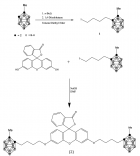
Figure 6
Similar Articles
-
Synthesis and Biological Evaluation of Fluorescein-Tagged 1-Methyl-o-carborane for Boron Neutron Capture TherapyLucas A Kuzmanic,Lauren E Zuidema,Jason A Misurelli,Kazuko Uno,Sherine F Elsawa*,Masao Takagaki*,Narayan S Hosmane*. Synthesis and Biological Evaluation of Fluorescein-Tagged 1-Methyl-o-carborane for Boron Neutron Capture Therapy. . 2018 doi: 10.29328/journal.aac.1001016; 2: 075-081
-
Nuclear science and magnetic carbon: a promising way from a chemical method to detect and fight cancer and tumors/neoplasmsEB Simão-Silva, NFG Serrano, MPC de Medeiros, AJ Boareto-Mendes, JF Galdino, FM Araujo-Moreira*. Nuclear science and magnetic carbon: a promising way from a chemical method to detect and fight cancer and tumors/neoplasms. . 2023 doi: 10.29328/journal.aac.1001042; 7: 047-050
Recently Viewed
-
Obesity in Patients with Chronic Obstructive Pulmonary Disease as a Separate Clinical PhenotypeDaria A Prokonich*, Tatiana V Saprina, Ekaterina B Bukreeva. Obesity in Patients with Chronic Obstructive Pulmonary Disease as a Separate Clinical Phenotype. J Pulmonol Respir Res. 2024: doi: 10.29328/journal.jprr.1001060; 8: 053-055
-
Current Practices for Severe Alpha-1 Antitrypsin Deficiency Associated COPD and EmphysemaMJ Nicholson*, M Seigo. Current Practices for Severe Alpha-1 Antitrypsin Deficiency Associated COPD and Emphysema. J Pulmonol Respir Res. 2024: doi: 10.29328/journal.jprr.1001058; 8: 044-047
-
Navigating Neurodegenerative Disorders: A Comprehensive Review of Current and Emerging Therapies for Neurodegenerative DisordersShashikant Kharat*, Sanjana Mali*, Gayatri Korade, Rakhi Gaykar. Navigating Neurodegenerative Disorders: A Comprehensive Review of Current and Emerging Therapies for Neurodegenerative Disorders. J Neurosci Neurol Disord. 2024: doi: 10.29328/journal.jnnd.1001095; 8: 033-046
-
Metastatic Brain Melanoma: A Rare Case with Review of LiteratureNeha Singh,Gaurav Raj,Akshay Kumar,Deepak Kumar Singh,Shivansh Dixit,Kaustubh Gupta*. Metastatic Brain Melanoma: A Rare Case with Review of Literature. J Radiol Oncol. 2025: doi: 10.29328/journal.jro.1001080; 9: 050-053
-
Validation of Prognostic Scores for Attempted Vaginal Delivery in Scar UterusMouiman Soukaina*,Mourran Oumaima,Etber Amina,Zeraidi Najia,Slaoui Aziz,Baydada Aziz. Validation of Prognostic Scores for Attempted Vaginal Delivery in Scar Uterus. Clin J Obstet Gynecol. 2025: doi: 10.29328/journal.cjog.1001185; 8: 023-029
Most Viewed
-
Evaluation of Biostimulants Based on Recovered Protein Hydrolysates from Animal By-products as Plant Growth EnhancersH Pérez-Aguilar*, M Lacruz-Asaro, F Arán-Ais. Evaluation of Biostimulants Based on Recovered Protein Hydrolysates from Animal By-products as Plant Growth Enhancers. J Plant Sci Phytopathol. 2023 doi: 10.29328/journal.jpsp.1001104; 7: 042-047
-
Sinonasal Myxoma Extending into the Orbit in a 4-Year Old: A Case PresentationJulian A Purrinos*, Ramzi Younis. Sinonasal Myxoma Extending into the Orbit in a 4-Year Old: A Case Presentation. Arch Case Rep. 2024 doi: 10.29328/journal.acr.1001099; 8: 075-077
-
Feasibility study of magnetic sensing for detecting single-neuron action potentialsDenis Tonini,Kai Wu,Renata Saha,Jian-Ping Wang*. Feasibility study of magnetic sensing for detecting single-neuron action potentials. Ann Biomed Sci Eng. 2022 doi: 10.29328/journal.abse.1001018; 6: 019-029
-
Pediatric Dysgerminoma: Unveiling a Rare Ovarian TumorFaten Limaiem*, Khalil Saffar, Ahmed Halouani. Pediatric Dysgerminoma: Unveiling a Rare Ovarian Tumor. Arch Case Rep. 2024 doi: 10.29328/journal.acr.1001087; 8: 010-013
-
Physical activity can change the physiological and psychological circumstances during COVID-19 pandemic: A narrative reviewKhashayar Maroufi*. Physical activity can change the physiological and psychological circumstances during COVID-19 pandemic: A narrative review. J Sports Med Ther. 2021 doi: 10.29328/journal.jsmt.1001051; 6: 001-007

HSPI: We're glad you're here. Please click "create a new Query" if you are a new visitor to our website and need further information from us.
If you are already a member of our network and need to keep track of any developments regarding a question you have already submitted, click "take me to my Query."







